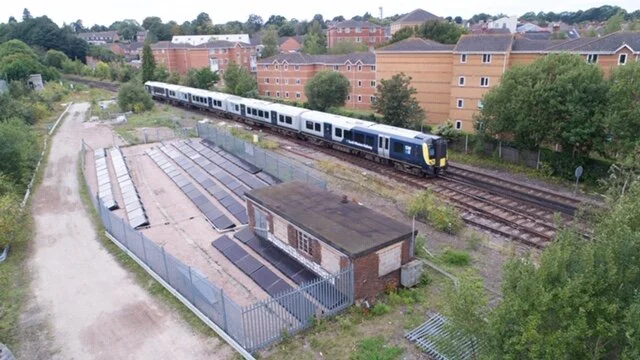Our Work so far
At its core, this is a pretty simple idea. Solar farms would be installed next to the train tracks - on train sheds, nearby fields and industrial buildings. These would not connect to the grid as a usual solar array might. Instead, they’d power the railway directly to provide traction power for the trains.
But was this idea possible? In 2017, Possible (then known as 10:10 climate action) brought together experts from the Energy Futures Lab at Imperial College London, Community Energy South, and electrical engineering specialists Turbo Power Systems (TPS) to find out.
After extensive technical work we confirmed that yes, solar PV can be installed by the railway line and connected directly to electrified track to provide traction power for trains. You can bypass the grid completely.
Our research found that solar traction power could provide at least one tenth of the energy needed to power trains on the UK’s DC electrified routes every year. Not only that, but it also makes sense financially for solar farms and rail operators right now, with no need for public subsidy support. And there’s huge potential to make this happen in the UK, and around the world.
Community energy - where local people own the renewable energy and benefit from it - is at the heart of this work (the whole idea had come from them in the first place!). Our mission is to see community- and commuter-owned solar farms powering the railways - for the benefit of the railway routes, the communities that host them and of course the planet.
Since the initial eureka moment, we have been honing the technology with Network Rail to make it as safe and efficient as possible, and in summer 2019 we connected our ‘First Light’ pilot solar array of just over 100 panels to the railway at our demonstrator site, outside Aldershot station in the UK. The trial was a success, proving that solar PV can feed power directly into DC third rail electric traction networks without causing either system to malfunction.
Since then, we have been working with local community energy groups to conduct feasibility studies on six potential Megawatt scale solar sites in the South East of England, including Cuckmere Community Solar in Berwick. Unfortunately, site-specific technical issues which came to light as the project progressed proved impossible to overcome, and were exacerbated by Covid, so Cuckmere was not able to proceed. During three years of hard work, Network Rail Southern Region and Riding Sunbeams have learned a huge amount from the process. Both organisations will continue to pursue projects to prove the concept of solar energy powering trains and its role in achieving the UK’s Net Zero commitments.
Alongside our DC work, we have also been working with TPS and the traction system engineers in the Wales & Western Region, to develop a bespoke converter for direct supply to AC overhead electrified routes, as well as exploring the potential for integrating other clean energy technologies like wind power and battery storage.
Aldershot solar farm

